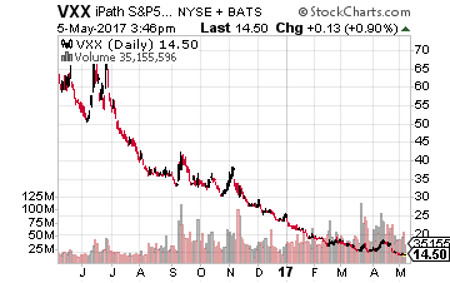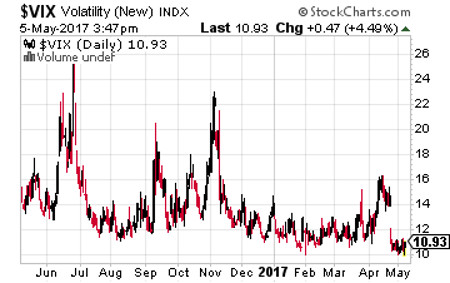Worrying about what will happen if the market crashes will never accomplish anything, but most investors never plan to profit if the market takes a dive. This trade acts as “insurance” against a market sell-off, notes Jay Soloff, editor of Investors Alley.
From a volatility standpoint, the stock market has been incredibly boring lately. It’s almost too boring, to the point you wonder if we’re going to wake up tomorrow with the world on fire. It can be a very difficult environment to trade in, wondering when the other shoe is going to drop.
Of course, the shoe -– in this case, a spike in volatility may not come for weeks or months. On one hand, you don’t want to be caught on the wrong side of a short volatility trade. That’s a recipe for disaster.
On the other hand, if volatility remains this low, you’ll be missing out on a potentially decent yield from selling volatility.
In fact, volatility selling has become the go to trade for professionals and casual traders alike. With the widespread adoption of volatility ETPs, it’s become easier than ever to trade volatility -– or more specifically, short volatility.
Just look at this chart of iPath S&P 500 VIX Short-Term Future ETN (VXX) — is most heavily traded (and shorted) of the volatility ETPs. It trades more than 50 million shares a day on average.
As you can see, you could almost do no wrong shorting VXX. Due to the low volatility markets we’ve been in, well, for the last year at least, selling volatility would have been entirely successful the vast majority of the time.
The fact of the matter is selling volatility has been so successful, the crowd (investors/traders) are relying on it for yield. So many people are shorting volatility, it’s actually pushing volatility to historically low levels.
Just look at this chart of the S&P 500 Options Volatility Index (VIX), which of course is what the VXX is based on. Even in this ultra-low volatility period, we’ve fallen even lower than normal. The index dropped below 10 just recently — a level it has closed below less than 10 times in its entire history.
So that means it’s time to buy volatility/VIX/VXX here, right? After all, there’s mean reversion, betting against the crowd, and all that. And, I agree it seems like a logical strategy given the uncertain geopolitical environment and the unpredictable nature of the current domestic administration.
However, it’s not that easy (it never is). The thing is, as low as the VIX has been, keep in mind it’s a measure of implied volatility. For those who aren’t aware, implied volatility is a measure of future volatility expectations.
It’s what the market thinks is going to happen. So the market has been expecting average S&P 500 volatility (as measured by the VIX) to be around 10 recently and generally no higher than 13 for most of 2017 to date.
Guess what actual (realized) volatility has been in the S&P 500? Well, right now it’s about 6%. Last week it was around 7%. Last month… 7%. In other words, implied volatility has actually been overstating volatility risk for quite some time.
It’s normal for implied volatility to be higher than realized volatility because people are generally more worried about the future than complacent about it. Still, implied volatility has been running 4% to 5% higher than realized for most of the year. It does lend credence to what the volatility sellers are doing.
So how do we trade in this current environment? Let me start with this. Unless you’re a fund that has to generate yield each and every month, I don’t recommend shorting volatility when it’s this low.
When volatility does spike, it can move really fast. And, it’s very possible you won’t have time to exit your short trade. Instead, under current circumstances, you can buy VIX upside for very cheap.
Since it’s so cheap, you don’t have to try to hit a home run and wait for VIX to hit 20 or higher. You can buy a mid-level VIX call spread (expiring in a month) for peanuts.
For example, the VIX 12-15 call spread (buying the 12 strike and selling the 15 strike) expiring at the end of May only costs $0.75.
That’s a break-even point of $12.75 in VIX — a level it could easily hit when you wake up tomorrow. Max gain is $2.25, so you’re talking about a 3 to 1 risk/reward ratio. Hard to beat that.
Even if you don’t believe volatility is ready to spike, this is a cheap way to take advantage of even just a small uptick. Not to mention, it’s a nice, affordable way to buy insurance if you’re long in the market, like most of us who own stocks.























